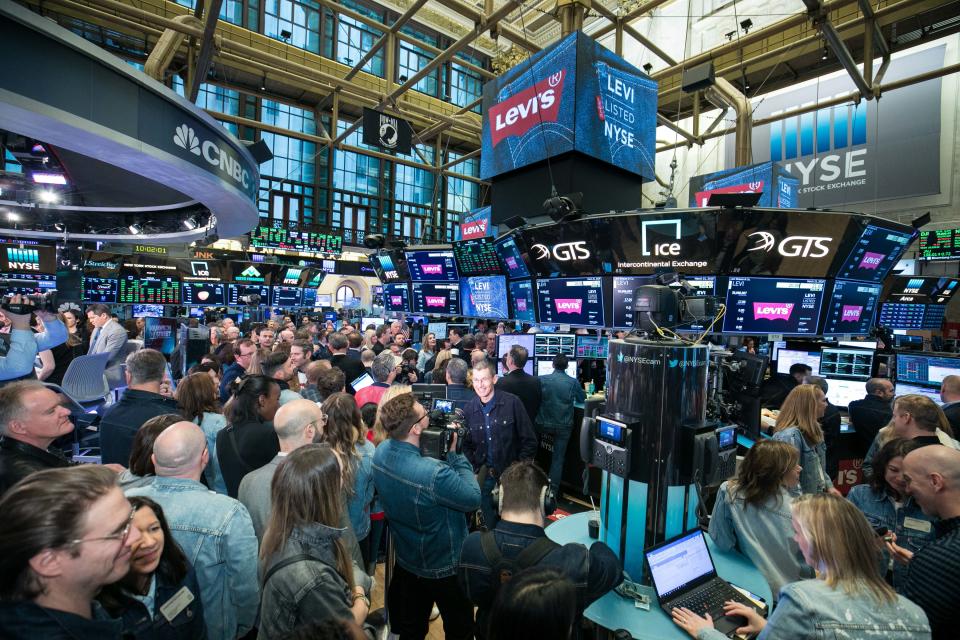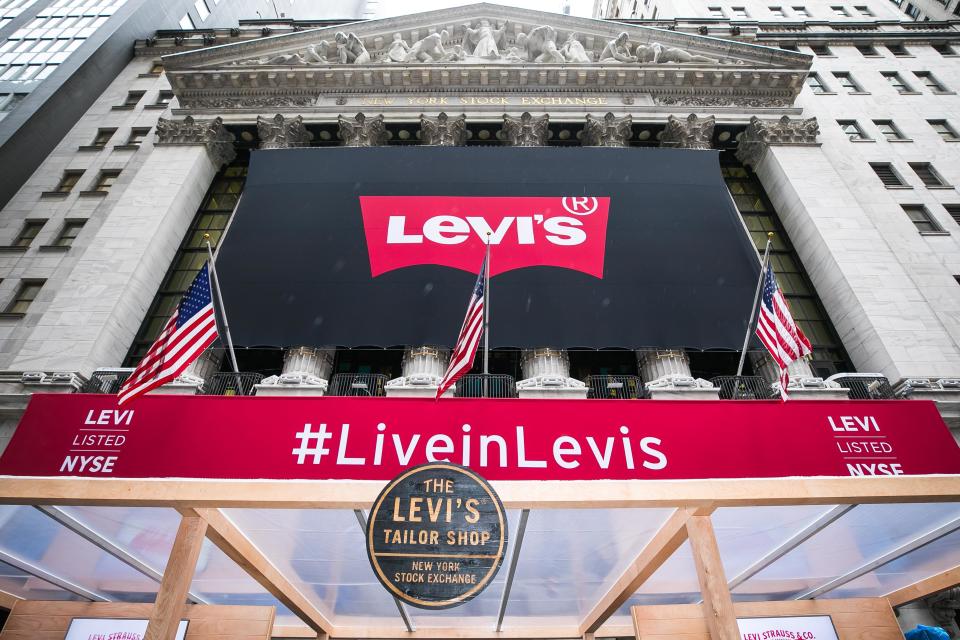On the Ground at the New York Stock Exchange for the Levi's IPO
“BLUE JEANS NOT PERMITTED ON TRADING FLOOR,” reads a sign—ironically enough in Levi’s-tab red—near the entrance to the New York Stock Exchange floor. The sign is hard to reconcile with what I see next: every trader on the floor is dressed in full rodeo gear, denim from their ankles to their necks. On any other day, this would appear to be a mass revolt against the outfit constraints instituted by the New York Stock Exchange. Today, it’s a celebration of the market’s latest entrant: iconic 166-year-old denim brand Levi’s.
The gathering of the Canadian tuxedos is at least a month in the making, a process that began when Levi’s announced its intentions to go public in early February. Levi’s, a brand as synonymous with jeans as Kleenex with tissues, is intent on continuing to grow beyond its signature invention. Accomplishing that goal will require a massive influx of cash, which is why the company offered 36.7 million shares to investors in order to raise $623 million. (Last year the company reportedly earned $258.2, an impossible-to-imagine number but still only a fraction of the money raised Thursday alone.) The NYSE might be familiar to Levi’s lifers—the company briefly went public in 1971 before it reverted into a private company 14 years later, in 1985. Now, it’s going through another IPO (Or initial public offering, the process by which a company transitions from private to publicly traded) in style.
Out on the floor, one trader is dressed in jeans and a trucker jacket adorned with New York Mets pins. He shouts to no one in the scrum in particular that he used to have a Black Sabbath jacket just like this one. Now, he’s gotten used to the suit he has to wear to work everyday—the full denim getup is a little hot for the floor, he tells me. This is only the second time traders have been granted permission to wear denim on the NYSE floor. (The first was in 2009, when they wore Gap jeans to commemorate the brand’s 40th anniversary.)

The idea to put the traders in head-to-toe denim was actually put forth by executives at the NYSE, according to Jennifer Sey, Levi’s CMO. So a month ago, traders were fitted for jeans and a jacket so they could create a cohesive, statement-making moment. “People think they can’t wear head-to-toe Levi's, but they can,” Sey laughs.
But it isn’t entirely a gimmick: the traders were showing off how Levi’s, as it jumps into the wild world of public trading, is trying to move beyond just being the most important jeans brand in the world—and what might happen if it reaches its goals.
About those: just a week ago, Levi’s shares were expected to start trading somewhere between $14 and $16. On Wednesday, it was reported the initial offering would open a touch above that, at $17. The number climbed all the way to $22.22 before it became available to the public. On the morning of, the figure is announced almost barbacilly, by a man doing his best Braveheart impression and yelling out the finalized price just before it starts trading.
Watch:
John Mayer Explains His Personal Style
That’s a number that will put a smile on Levi’s executive faces, but the fact remains that Levi’s was an incredibly successful private company—it’s still the number one purveyor of denim in the world. The IPO raises a lot of questions about what a classic apparel brand like Levi’s has to gain from going public now.
The most obvious answer, as Sey puts it to me in a conference room covered in pictures and oil paintings of the very building we’re in, is that, “It's a way to generate capital to invest back into the business.” That money will go towards building new stores, investing more in technology like lasers that can instantly customize jeans with whatever designs customers can dream up, and crafting a more user-friendly website. One other reason that’s been widely reported: the IPO gives the Haas family, descendants of brand founder Levi Strauss, the chance to cash out some of their stake in the company.
Sey says that from a customer perspective the IPO won’t affect the day-to-day experience. Levi’s, which is already seemingly everywhere, just might be more omnipresent in our lives if it can fulfill its goals of opening more stores—Sey believes the brand is “underpenetrated” in the U.S. with only 31 standalone shops—and then selling even more denim through them. Despite the fact that it’s already moving more jeans than any other brand, Levi’s believes there is still plenty of room to grow.
Levi’s, known almost entirely for its denim, wants to stretch itself out into other categories, like tops. Maybe a customer wanders into a store looking for a new pair of 501s, but they leave with T-shirts and a trucker jacket to round out the look. And Levi’s, like seemingly every other fashion label in the world, also has its eyes on China as a place where the roof on sales is still a long ways away.
The brand might face headwinds. Before today’s IPO, analysts pointed out that trends in pants are not moving in Levi’s direction: Denim sales are only expected to grow two percent a year until 2023. Meanwhile, pleated trousers, joggers, and Dickies are taking up more and more room in men’s closets.

So Levi’s is fighting back. If customers are looking for comfort, the company will give them jeans with stretch. If joggers are hot because men wear them to show off their sneakers, Levi’s will invent a jean that does exactly that. Sey says that if denim is ever anything but white-hot, Levi’s isn’t doing its job. “There have been moments when the category has waned and I would say as the leader in the category we weren’t offering a lot of newness at that time.” Sey says. “So maybe that was on us a little bit.”
Still, fashion brands like Levi’s feel different from most other companies traded on the New York Stock Exchange. Trends can wreak havoc, or prop up a brand that makes clothes that fit into how people want to dress in that particular moment. By contrast, analysts aren’t coming out declaring that iPhones are so not hot for spring and tanking Apple’s value in the process. Even compared to other clothing-focused companies, Levi’s feels different. The apparel brands that have gone public recently—retailers Farfetch and Revolve, along with styling-by-algorithm brand Stitch Fix—position themselves as technology companies that happen to work in the medium of fashion. Levi’s is...not that.
Sey isn’t worried. If the denim-clad traders are proof of anything, it’s that Levi’s is not a company easily boxed in by what typically happens. “We're not like other apparel brands,” she asserts. “Something like 80 percent of men have a pair of Levi's in their closet… Nobody thinks of Nike [another publicly traded company] as at the whims of trends. They create the trends and that's what we aim to do.”
And on this day, that’s exactly what happens: Levi’s finishes the day up from where the the stock started, at $22.41, putting the company’s value at $8.7 billion.

